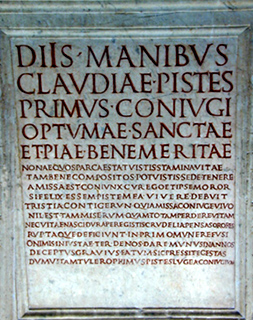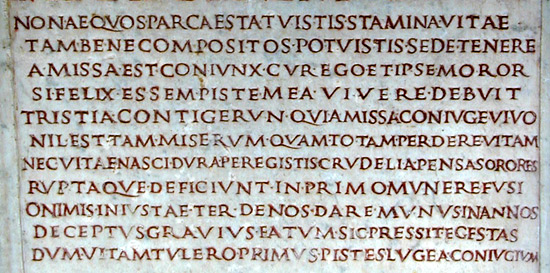Claudia Piste, a much loved wife, was memorialized by her husband with this handsome marble tombstone inscribed with a touching poem written in his name. The tombstone is sizeable, with extensive carving in elegantly formed letters decorated in red paint that is still visible (the graceful serifs suggest a date for the stone between 1st-2nd century CE). Piste's age at death or the length of their marriage is referred to ambiguously in line 9 of the poem. The cause of death is rarely mentioned in inscriptions, but one reading of lines 6-7 would make her death the result of childbirth, a common enough fate for Roman women. She is called coniunx, which is strong evidence that they are not slaves, to whom legal marriage was forbidden. Claudia's nomen, associating her with the Claudian family, together with Piste, her cognomen, which is of Greek origin, is the typical formula for a freedwoman's name (see names); Primus' use of a single name rather than the three used formally by Roman male citizens, may be more a product of his Roman citizenship in Greece (see I. Kajanto and H. Solin in the Companion Bibliography) than a sign of his freed status. That they were wealthy may be deduced from Piste's tombstone, which was expensive; if Primus had hired a poet to cast his sentiment into verse, the expense would have been even greater. As with many epitaphs that go beyond the formulaic heading (lines 1-5), the writer's meaning is not always clear: punctuation (beyond word separation) is absent and spelling and grammar reflect the spoken language; further difficulties arise when the eulogy is cast into verse. The poem is a poignant lament addressed by Primus to the Fates, remonstrating with them on the brevity of Piste's life and expressing his despair over her loss. His grief for her death is artfully communicated through language, meter and word placement (especially in the final verse).
 Funerary cippus of Claudia Piste |
|
 Eulogy in dactylic hexameter: metrical description |
| 1 | NON AEQUOS, PARCAE, STATUISTIS STAMINA VITAE, | |
| TAM BENE COMPOSITOS POTUISTIS SEDE TENERE. | ||
| AMISSA EST CONIUNX. CUR EGO ET IPSE MOROR? | ||
| SI FELIX ESSEM, PISTE MEA VIVERE DEBUIT. | ||
| 5 | TRISTIA CONTIGERUN[t], QUI AMISSA CONIUGE VIVO[nt]. | |
| NIL EST TAM MISERUM QUAM TOTAM PERDERE VITAM | ||
| NEC VITAE NASCI. DURA PEREGISTIS CRUDELIA PENSA, SORORES, | ||
| RUPTAQUE DEFICIUNT IN PRIMO MUNERE FUSI. | ||
| O NIMIS INIUSTAE, TER DENOS DARE MUNUS IN ANNOS! | ||
| 10 | DECEPTUS. GRAVIUS FATUM SIC PRESSIT EGESTAS. | |
| DUM VITAM TULERO, PRIMUS PISTES LUGEA[m] CONIUGIUM |
Click on the underlined words for translation aids and
commentary, which will appear in a small window. Click on the icon link
![]() to the right of the
poem for related images and information.Close the small window after each use.
to the right of the
poem for related images and information.Close the small window after each use.